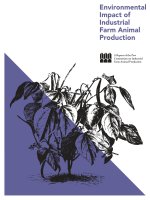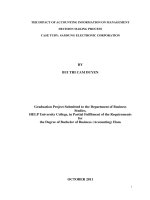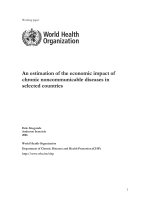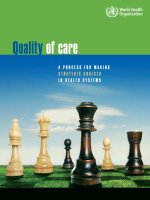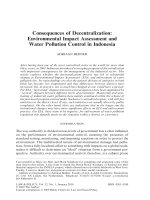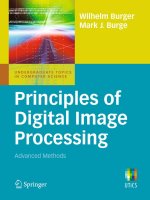Environmental impact estimation of mold making process
Bạn đang xem bản rút gọn của tài liệu. Xem và tải ngay bản đầy đủ của tài liệu tại đây (12.58 MB, 125 trang )
Environmental impact estimation of mold making process
by
Daeyoung Kong
A dissertation submitted in partial satisfaction of the
requirements for the degree of
Doctor of Philosophy
in
Engineering - Mechanical Engineering
in the
Graduate Division
of the
University of California, Berkeley
Committee in charge:
Professor David Dornfeld, Chair
Professor Paul Wright
Professor Sara Beckman
Fall 2013
UMI Number: 3616372
All rights reserved
INFORMATION TO ALL USERS
The quality of this reproduction is dependent upon the quality of the copy submitted.
In the unlikely event that the author did not send a complete manuscript
and there are missing pages, these will be noted. Also, if material had to be removed,
a note will indicate the deletion.
UMI 3616372
Published by ProQuest LLC (2014). Copyright in the Dissertation held by the Author.
Microform Edition © ProQuest LLC.
All rights reserved. This work is protected against
unauthorized copying under Title 17, United States Code
ProQuest LLC.
789 East Eisenhower Parkway
P.O. Box 1346
Ann Arbor, MI 48106 - 1346
Environmental impact estimation of mold making process
©2013
by
Daeyoung Kong
Abstract
Environmental impact estimation of mold making process
by
Daeyoung Kong
Doctor of Philosophy in Engineering - Mechanical Engineering
University of California, Berkeley
Professor David Dornfeld, Chair
Increasing concern of environmental sustainability regarding depletion of natural resources
and resulting negative environmental impact has triggered various movements to address these
issues. Various regulations about product life cycle have been made and applied to industries. As
a result, how to evaluate the environmental impact and how to improve current technologies has
become an important issue to product developers. Molds and dies are very generally used
manufacturing tools and indispensible parts to the production of many products. However,
evaluating environmental impact in mold and die manufacturing is not well understood and not
much accepted yet.
The objective of this thesis is to provide an effective and straightforward way of
environmental analysis for mold and die manufacturing practice. For this, current limitations of
existing tools were identified. While conventional life cycle assessment tools provide a lot of life
cycle inventories, reliable data is not sufficient for the mold and die manufacturer. Even with
comprehensive data input, current life cycle assessment (LCA) tools only provide another
comprehensive result which is not directly applicable to problem solving. These issues are
critical especially to the mold and die manufacturer with limited resource and time.
This thesis addresses the issues based on understanding the needs of mold and die
manufacturers. Computer Aided Manufacturing (CAM) is the most frequently used software tool
and includes most manufacturing information including the process definition and sometimes
geometric modeling. Another important usage of CAM software tools is problem identification
by process simulation. Under the virtual environment, possible problems are detected and solved.
Environmental impact can be handled in the same manner. To manufacture molds and dies with
minimizing the associated environmental impact, possible environmental impact sources must be
minimized before execution in the virtual environment.
Molds and dies are manufacturing-intensive products and most of their environmental
impact is generated by energy consumption during the machining processes. Milling and Electric
1
Discharge Machining (EDM) operations were selected as the most influential mold and die
manufacturing processes. Process variability was found to be the key issue which must be
addressed for reliable analysis. Acceleration and deceleration in the milling process and the
dielectric contamination and resultant decrease of material removal rate (MRR) in the EDM
process were identified as main factors for the variability. Energy consumption of these two
processes were analyzed and modeled including the variability. Experiments were carried out to
validate and improve this model. Finally, this model is implemented as simulation software tools
on the basis of CAM software (Esprit CAMTM).
The CAM-based tool developed in this study can be more easily used in the mold and die
manufacturing practice. Considering the variety of molds and dies and their application, this tool
would be just a small step along the way to environmentally benign mold and die manufacturing.
However, with further research, the tool developed in this thesis will result in an effective way to
address environmentally benign mold and die manufacturing.
2
To My Family
i
Table of Contents
Table of Contents. ........................................................................................................................... ii
List of Figures ................................................................................................................................ vi
List of Tables. ................................................................................................................................ ix
Acknowledgement .......................................................................................................................... x
Curriculum Vitae and Publications. ............................................................................................... xi
Chapter 1
1.1
Introduction ............................................................................................................... 1
Environmental sustainability ............................................................................................ 1
1.1.1
Energy & resource concerns ..................................................................................... 1
1.1.2
Influence of manufacturing sector ............................................................................ 3
1.2
Metal fabrication and the environmental impact.............................................................. 5
1.2.1
Plant based manufacturing sector ............................................................................. 5
1.2.2
Fabricated metal manufacturing sector ..................................................................... 5
1.2.3
Machine tool energy consumption ............................................................................ 6
1.3
Objective of this dissertation ............................................................................................ 7
1.4
Contribution of this research ............................................................................................ 7
1.5
Outline of dissertation ...................................................................................................... 8
Chapter 2
Mold and Die Manufacturing.................................................................................... 9
2.1
Introduction to molds and dies ......................................................................................... 9
2.2
Molds and dies ................................................................................................................. 9
2.3
Influence of molds and dies in the product development............................................... 11
2.4
Environmental impact of mold and die .......................................................................... 13
2.5
Conclusion...................................................................................................................... 15
Chapter 3
Information System and Mold and die manufacturing ........................................... 16
3.1
Introduction .................................................................................................................... 16
3.2
Information system and energy consumption in mold making ...................................... 17
ii
3.3
Life cycle assessment (LCA) tools................................................................................. 18
3.4
CAD-based LCA tools ................................................................................................... 19
3.5
LCA tools for mold and die manufacturing ................................................................... 20
3.6
Conclusion...................................................................................................................... 21
Chapter 4
Environmental Impact of CNC Milling .................................................................. 23
4.1
Introduction .................................................................................................................... 23
4.2
Environmental impact of the manufacturing process ..................................................... 23
4.3
Breakdown of Energy Consumption of CNC Milling Machines ................................... 25
4.4
Current methods ............................................................................................................. 26
4.4.1
Power demand information for CNC milling components ..................................... 26
4.4.2
Specific energy of CNC milling process ................................................................ 28
4.4.3
Limitation of current methods ................................................................................ 30
4.5
Cutting Power of Milling Process .................................................................................. 31
4.6
Acceleration and Deceleration ....................................................................................... 34
4.7
Structural Configuration of a Machine Tool and Direction of Axes Movement ........... 39
4.8
Tare energy and cycle time prediction ........................................................................... 41
4.9
Impact of Geographical Region on the Green House Gas Emission ............................. 42
4.10
Experimental Validation ................................................................................................ 44
4.10.1
Rectangular pocket tool path .................................................................................. 46
4.10.2
Curved profiles........................................................................................................ 47
4.10.3
Influence of the segment length .............................................................................. 49
4.11
Milling process and software simulation ....................................................................... 49
4.12
Modeling ........................................................................................................................ 50
4.13
Implementation............................................................................................................... 51
4.13.1
Web-based Software Implementation ..................................................................... 51
4.13.2
API-based Software Implementation ...................................................................... 52
4.14
Test Cases....................................................................................................................... 53
4.14.1
Rectangular pocket milling with different tool path patterns ................................. 53
4.14.2
Various surface shapes with different tool path patterns ........................................ 55
4.15
Conclusion...................................................................................................................... 57
Chapter 5
Environmental impact of Electric discharge machining ......................................... 59
iii
5.1
Introduction .................................................................................................................... 59
5.2
Basic theory of EDM...................................................................................................... 60
5.2.1
Die sinking EDM and wire-EDM ........................................................................... 61
5.2.2
EDM components ................................................................................................... 62
5.3
Process parameters in EDM ........................................................................................... 63
5.3.1
Single discharge ...................................................................................................... 63
5.3.2
Discharge cycle ....................................................................................................... 66
5.3.3
Gap control and flushing ......................................................................................... 69
5.3.4
Electrode material ................................................................................................... 71
5.4
Cycle time variance consideration ................................................................................. 71
5.4.1
Time delay during pulse on time ............................................................................ 71
5.4.2
Inconsistent MRR ................................................................................................... 72
5.5
Environmental impact of EDM ...................................................................................... 74
5.5.1
Energy consumption for material removal in EDM ............................................... 75
5.5.2
Peripheral devices ................................................................................................... 76
5.5.3
Waste of material .................................................................................................... 76
5.5.4
Energy consumption of EDM ................................................................................. 77
5.6
Machine data acquisition ................................................................................................ 78
5.6.1
Experiment setup and restrictions ........................................................................... 78
5.6.2
Experiment results and consideration ..................................................................... 79
5.7
Modeling ........................................................................................................................ 81
5.8
Implementation............................................................................................................... 81
5.9
Test case and analysis .................................................................................................... 82
5.10
Conclusion...................................................................................................................... 83
Chapter 6
Environmental Impact of Mold Making ................................................................. 85
6.1
Introduction .................................................................................................................... 85
6.2
Software simulation in mold and die manufacturing ..................................................... 86
6.3
CAM-based environmental impact estimation ............................................................... 86
6.4
Test Case and analysis.................................................................................................... 87
6.5
Process planning............................................................................................................. 89
6.6
Conclusion...................................................................................................................... 90
iv
Chapter 7
Summary and Conclusions ..................................................................................... 91
7.1
CAM-based process analysis of molds and dies making ............................................... 91
7.2
Future works................................................................................................................... 91
7.2.1
Collaborative mold and die manufacturing............................................................. 92
7.2.2
The leveraging impact of molds and dies ............................................................... 93
Bibliography ................................................................................................................................. 95
Appendix A
Estimation Software Tool.................................................................................. 104
A.1
Esprit API ..................................................................................................................... 104
A.2
Graphic User Interface ................................................................................................. 105
A.2.1
Operation Analysis Dialog .................................................................................... 105
A.2.2
Milling Operation Dialog ...................................................................................... 107
A.2.3
EDM Operation Dialog ......................................................................................... 108
v
List of Figures
Figure 1.1. Crude Oil Price Change [1] ................................................................................... 2
Figure 1.2. U.S. Electricity Production Costs (C/kWh) [2] .................................................... 2
Figure 1.3. World atmospheric concentration of CO2 and average global temperature
change [3].............................................................................................................. 3
Figure 1.4. (a) Total final energy consumption and (b) total direct and indirect CO2
emissions [7] ......................................................................................................... 4
Figure 1.5. Primary energy use and emissions in U.S. Manufacturing sectors [8] .................. 4
Figure 1.6. LCA results of machine tool use phase [10] ......................................................... 6
Figure 2.1. (a) Molds for cell-phone covers and (b) dies for automobile cover sheet metal
body components ................................................................................................ 10
Figure 2.2. Basic mold base structure and injection molding mechanism............................. 11
Figure 2.3. (a) Global mold and die production values and [28] (b) mold and die market
needs in different countries [29] ......................................................................... 12
Figure 2.4. Process parameters of mold & die manufacturing process ................................. 13
Figure 2.5. (a) Life cycle cost of progressive die [33], (b) automotive part by injection
molding [34]........................................................................................................ 14
Figure 2.6. Time distribution in mold making [36] ............................................................... 14
Figure 3.1. Various software tools in product development .................................................. 16
Figure 3.2. (a) Gabi4 LCA Tool [PE International], (b) Registration year of life cycle
inventory data in NREL database ....................................................................... 18
Figure 3.3. Environmental impact estimation based on two main processes ........................ 21
Figure 4.1. Resource flow for manufacturing processes [13] ................................................ 24
Figure 4.2. Machining energy breakdown for a 1998 Bridgeport milling machine [14]....... 25
Figure 4.3. Variation of energy consumption over a range of different feed speeds [46] ..... 27
Figure 4.4. Specific energy as a function of MRR for Mori Seiki NVD 1500 [50] .............. 29
Figure 4.5. Specific electricity requirements for various manufacturing processes [51] ...... 30
Figure 4.6. Visualized (a) tool swept volume and (b) machined workpiece in milling
operations [56] .................................................................................................... 31
Figure 4.7. Geometric schematic of the vertical milling operation (climb milling) (a)
isometric and (b) top view .................................................................................. 32
Figure 4.8. Impact of surface geometric complexity and programmed feed rate on the actual
cycle time during HSM [61] ............................................................................... 35
Figure 4.9. Acceleration and deceleration of machine tool axes to reach a specified feed rate
............................................................................................................................. 36
Figure 4.10. (a) Acceleration and deceleration of machine tool axes with small direction
change, (b) position discrepancy in tool trajectory ............................................. 37
Figure 4.11. Temporal deviation according to tool path segment length .............................. 39
Figure 4.12. Different power demand of jogging the Mori Seiki NVD 1500 milling machine
............................................................................................................................. 40
Figure 4.13. Maximum feed rate and direction of cutting tool movement. ........................... 41
Figure 4.14. Power consumption distribution of Mori Seiki NVD1500 [66] ........................ 41
Figure 4.15. Energy mix in the USA from U.S. EIA 08 [7] .................................................. 44
Figure 4.16. Energy mix of several countries for electricity generation [74] ........................ 44
vi
Figure 4.17. Power meter (CW240) connection to NVD 1500 ............................................. 45
Figure 4.18. Rectangular pocket and curved profile tool paths ............................................. 45
Figure 4.19. Power profile and machining for rectangular pocket milling ............................ 46
Figure 4.20. Power profile with different load conditions ..................................................... 47
Figure 4.21. Power profile of curves profile milling with 800mm/min feed rate .................. 48
Figure 4.22. Power profile of curves profile milling with 1500mm/min feed rate ................ 48
Figure 4.23. Discrepancy rate of actual cycle time to ideal time in (a) a rectangular pocket
tool paths and in (b) a curved profile. ................................................................. 49
Figure 4.24. Process flow for tool path planning incorporating a sustainability concern ..... 50
Figure 4.25. Architecture of the simulation software ............................................................ 51
Figure 4.26. Web-based simulation environment .................................................................. 52
Figure 4.27. API-based simulation environment ................................................................... 53
Figure 4.28. Processing time and energy consumption of various tool-paths ....................... 54
Figure 4.29. GHG emissions resulted from executing a sample tool path in five arbitrarily
chosen states (Figure 4.29 (a) shows all the GHG emissions and Figure 4.29 (b)
shows the GHGs except carbon dioxide.) ........................................................... 55
Figure 4.30. Tool path influence on the cycle time variation ................................................ 56
Figure 4.31. Green house gas emission as a result of electricity consumption for machining a
pocket shown in the left in Indiana ..................................................................... 56
Figure 5.1. Die sinking EDM usage by applications [35]...................................................... 59
Figure 5.2. Material removal by electric discharge ............................................................... 61
Figure 5.3. (a) Die sinking EDM and (b) 2 axis wire-EDM .................................................. 62
Figure 5.4. EDM operation parameters.................................................................................. 63
Figure 5.5. MRR versus current size for various duty cycles [86] ........................................ 64
Figure 5.6. MRR versus discharge voltage for various electric resistances [87] ................... 65
Figure 5.7. MRR and pulse duration time for different discharge currents [93] ................... 65
Figure 5.8. Discharge cycles of pulses in EDM..................................................................... 67
Figure 5.9. Three types of flushing in EDM .......................................................................... 69
Figure 5.10. Electrode jump up/down time in jet flushing .................................................... 70
Figure 5.11. Servo feed control [97] ...................................................................................... 72
Figure 5.12. Machining depth and MRR change [99] ........................................................... 72
Figure 5.13. (a) Jump height and machining depth relation in EDM and (b) schematics of
flushing [100] ...................................................................................................... 73
Figure 5.14. EDM ecological block scheme [82] .................................................................. 74
Figure 5.15. EDM power demands [80] ................................................................................ 76
Figure 5.16. EDM experimental setup and data acquisition .................................................. 78
Figure 5.17. Material removal depth with the current sizes .................................................. 79
Figure 5.18. MRR across different current sizes ................................................................... 80
Figure 5.19. (a) Machining depth with time and (b) corresponding duty factor ................... 80
Figure 5.20. Information flow of EDM process simulation incorporating sustainability ...... 81
Figure 5.21. CAM-based EDM process simulation ............................................................... 82
Figure 5.22. (a) MRR variation compared to circular area and (b) MRR variation across
different peripherals with respect to average value [106] ................................... 84
Figure 6.1. Mold making process flow with milling and EDM processes ............................ 85
Figure 6.2. Process design dialogs with Esprit CAM ............................................................ 87
vii
Figure 6.3. (a) Energy consumption in the CNC milling process with five different tool paths
and (b) in the EDM process for two depths of cylindrical cavities with three
current sizes ........................................................................................................ 88
Figure 6.4. (a) CO2 emissions and (b) other GHGs emissions by milling and EDM
operations across three different energy mixes ................................................... 89
Figure 7.1. Future work to support collaboration and management in mold and die
manufacturing ..................................................................................................... 92
Figure 7.2. Integration of manufacturing phase and use phase information of molds and dies
............................................................................................................................. 93
Figure A.1. Windows application development environment and Esprit API .................... 104
Figure A.2. Esprit API components ..................................................................................... 105
Figure A.3. Operation analysis dialog box .......................................................................... 106
Figure A.4. Milling operation dialog box ............................................................................ 107
Figure A.5. EDM operation dialog box ............................................................................... 108
viii
List of Tables
Table 2.1. Molds and dies share in product price [30]........................................................... 12
Table 3.1. Energy saving potential in the discrete part manufacturing by ICT (Information
and communication technology) [37] ................................................................. 17
Table 3.2. Simplified LCA approaches of major CAD developers ....................................... 20
Table 4.1. Component Use Matrix ......................................................................................... 28
Table 4.2. GHG emissions from electricity production with different source [71] ............... 43
Table 4.3. Green house gas emission rates for electricity generation by states. .................... 43
Table 4.4. Comparison of two implementation approaches. ................................................. 57
Table 5.1. e-Pack conditions for experiments ........................................................................ 79
Table 5.2. Process information supported by Esprit CAM. ................................................... 82
Table 5.3. Cycle time and energy consumption across different jump height ....................... 83
Table 6.1. Cycle time (sec) with different feed rates and tool path patterns in milling ......... 87
Table 6.2. Energy consumption with different current size in EDM ..................................... 88
Table 6.3. Process Comparative analysis adapted from [112] ............................................... 89
Table 6.4. Comparison of milling and EDM processes ......................................................... 90
Table A.1. Operation analysis dialog UI components ......................................................... 106
Table A.2. Milling operation dialog UI components ........................................................... 107
Table A.3. EDM operation dialog UI components .............................................................. 108
ix
Acknowledgement
First and foremost, I would like to thank my advisor, Professor David Dornfeld. He always
gave me a great advice and guided me through kindly support. When I was confused with my
research, with his help, I could find a way to overcome and with his encouragement, I could
advance. His help made me achieve more during my academic life at Berkeley and Ph.D study.
In particular, I would like to thank Professor Sara McMains. When I come to Berkeley after
a long time as a professional engineer, she helped me to get used to my late academic life as my
major advisor and advised me to structure my research work as chair of my qualifying
examination.
I also feel very grateful for Professor Sara Beckman. With her expertise in product
development and kind and professional advice, she helped me prepare and improve both my
presentation at my qualifying examination and this thesis.
I would like to express my gratitude to Professor Paul Wright. His expertise in
manufacturing helped me a lot during my qualifying examination and thesis preparation. His
advice also helped me prepare my first paper publication.
I would like to acknowledge all my past and current group members during my stay at the
Laboratory of Manufacturing and Sustainability. They created a great work environment.
Sometimes as a friend and sometimes as an advisor, they helped me have a great experience at
Berkeley.
Above all, I would like to thank my wife Yunhee and my daughters Jiyoo and Minchae for
their unconditional love and support. Thanks to them, I could get through my late academic life.
I would also thank my mother who always wishes my happiness and my sister for their love and
support.
x
Curriculum Vitae
1989 – 1993
Bachelor of Science
Mechanical Design and Production Engineering
Seoul National University
1993 – 1995
Master of Science
Mechanical Design and Production Engineering
Seoul National University
1995 – 2008
Engineer
Samsung Electronics Co.
2008 – 2013
Doctor of Philosophy
Mechanical Engineering (Minors: Electrical Engineering)
University of California, Berkeley
Publications
Daeyoung Kong, Seungchoun Choi, Yusuke Yasui, Sushrut Pavanaskar, David Dornfeld and
Paul Wright, “Software-Based Tool Path Evaluation For Environmental Sustainability”, Proc.
NAMRI/SME 39, 2011
Daeyoung Kong, Seungchoun Choi, Yusuke Yasui, Sushrut Pavanaskar, David Dornfeld and
Paul Wright, “Software-Based Tool Path Evaluation For Environmental Sustainability”, J.
Manufacturing Systems 30, 241–247, 2011
Daeyoung Kong, Seungchoun Choi, and David Dornfeld, “Software Support for
Environmentally Benign Mold Making Process and Operations”, Re-engineering Manufacturing
for Sustainability 279-284, 2013
Nancy Diaz, Seungchoun Choi, Moneer Helu, Yifen Chen, Stephen Jayanathan, Yusuke Yasui,
Daeyoung Kong, Sushrut Pavanaskar, and David Dornfeld, “Machine Tool Design and
Operation Strategies for Green Manufacturing”, Proc. 4th CIRP International Conference on
High Performance Cutting, 2010
xi
Chapter 1
Introduction
Introduction
This chapter provides background and motivation for this dissertation. The objective,
approach to achieve this, and expected contribution of this research will be briefly explained.
Finally, the outline of this dissertation will be briefly presented.
1.1 Environmental sustainability
Development of new technologies and advancement of manufacturing techniques has
improved the standard of living and enabled many new convenient products in daily life at low
cost. On the other hand, such technologies have accelerated the consumption of limited natural
resources, especially fossil based fuels like petroleum and coal. Abundant consumption of
resources brought another serious side effect with environmental problems like greenhouse gas
emissions and water pollution. Concerns about the environmental impact, a by-product of high
energy consumption, have raised environmental sustainability to become one of the important
criteria for product developers. Resource efficient and environmentally benign manufacturing
technology is getting more attention from product manufacturers these days.
1.1.1
Energy & resource concerns
Entering into the 21st century, increasing cost and depletion of natural resources have
become a serious issue for many different economic sectors due to limited availability of the
resources. Among this, dependency on fossil-based fuels is a very serious problem. While
electricity is an indispensible part in daily life and many researchers are working on the topic of
alternate energy sources like solar, waves, and wind, the high dependency on the fossil-based
fuels has not reduced very much if at all. Furthermore, the increase of electricity consumption
and production has been accelerated with growth of under-developed countries like China and
India. As a result, the distinct increase in the price of energy related resources is clearly seen.
According to an analysis shown in Figure 1.1, Crude oil prices have rapidly increased, rising
almost 600% since 1995 [1].
1
Crude oil price 1995 - 2011 ($/barrel)
120.00
100.00
80.00
60.00
40.00
20.00
0.00
Year
Figure 1.1. Crude Oil Price Change [1]
U.S. Electricity Production Costs and
Components ($0.01/kWh)
Because of its high dependency on pricey natural resources, US electricity production cost
has almost tripled for the same period [2]. Although the increase is lessened by improved
electricity-related technologies for power generation and transmission, the cost burden of
electricity production is huge under the inflation of natural resource costs. This trend is getting
more serious as shown in Figure 1.2. As a result, efficient electricity consumption and lower
environmental impact became an important criterion in many fields from factories to distribution.
35.00
30.00
Petroleum
25.00
Nuclear
Gas
20.00
Coal
15.00
10.00
5.00
0.00
Year
Figure 1.2. U.S. Electricity Production Costs (C/kWh) [2]
2
Global temperature change (ºC)
World atmospheric concentration
of CO2 (ppm)
However, even with increasing cost, fossil-based fuel is still generally competitive in price
compared with other clean energy sources [4]. CO2 emissions in the US have decreased with
reduced fossil-based fuel usage in recent years. However, with emissions in China and other
developing countries, world concentration of CO2 and average temperature keep increasing, as
Figure 1.3 [3].
Year
Figure 1.3. World atmospheric concentration of CO2 and average global temperature
change [3]
1.1.2
Influence of manufacturing sector
With respect to energy consumption and green house gas (GHG) emissions, the
manufacturing sector is known to be one of the biggest contributors among various sectors [5][6].
According to a 2007 International Energy Agency (IEA) report, manufacturing is responsible for
33% of total energy consumption and 38% of total direct or indirect CO2 emissions as shown in
Figure 1.4 [7]. Hence, without improving the manufacturing sector, the increasing environmental
issues cannot be effectively addressed.
3
Figure 1..4. (a) Total final energyy consumptioon and (b) tootal direct annd indirect CO2 emissionns [7]
Contribution to primary energy use and
emissions (%)
2
25%
2
20%
1
15%
P
Primary energy
y use (TBtu)
T
Total emissions
s (MMT CO2e)
1
10%
5%
0%
Figuure 1.5. Prim
mary energy use
u and emisssions in U.S
S. Manufactuuring sectorss [8]
Accoording to a report from
m the U.S Department
D
O Energy (DOE),
Of
(
varioous raw maaterial
processess are ranked
d as top enerrgy users am
mong U.S. maanufacturingg sectors [8]. Next to thee raw
material conversion processes likke chemicall production or iron andd steel makinng, transporttation
equipmennt and fabriccated metals are ranked high.
h
Even considering
c
t
their
popularrity in the market,
m
electronics and comp
puters rankedd lower. In terms
t
of GH
HG emissionss, most sectoors hold a similar
t that in energy use. Onnly petroleum
m refining and
a cement have
h
higher comparative
c
e rank
position to
and petrooleum showss the largest difference compared
c
too other sectorrs. Transporrtation equippment
and fabriicated metalss have similaar positions for emissionns as they haave in energyy use as show
wn in
Figure 1..5.
4
1.2 Metal fabrication and the environmental impact
The increased availability of natural gas has increased competitiveness versus coal and a
gas-fired combined cycle plant produces almost half the emissions per kilowatt hour than a coalfired plant [3]. By 2005, the U.S. used 23 percent less energy to produce a dollar of goods than in
1990, the reference year of the Kyoto climate treaty [6]. With technical development, U.S.
industry has reduced its carbon dioxide emissions for decades. However, compared with the EU
and Japan, the U.S. is still producing twice as much carbon dioxide and needs more improvement
[3].
1.2.1
Plant based manufacturing sector
In Figure 1.5, most of the top ranked manufacturing sectors with respect to consumption or
impact depend on mass production facilities. Plants with large equipment are used in these
sectors and the efficiency of the facilities directly leads to productivity and quality. Only small
numbers of different products are produced in large amounts: e.g., through processes with
complex pipe lines and different chemical facilities, different kinds of fuels, lubricants, and
asphalt are produced in the oil refinery sector. The plant is built and equipped with facilities
according to the required processes. Because the facilities are maintained generally through at
their life span, the process design is important: e.g., facilities of chemical plant and oil refinery
are expected to operate at least 10 to 15 years [9].
The manufacturing performance in this sector is improved mainly by process optimization
and more efficient facilities. To effect process optimization, various manufacturing parameters
are tested and evaluated for better performance. Through this procedure, optimal parameters are
selected and applied to practice and maintained. More efficient facilities can be applied to
improve performance but the overall process is maintained in many cases. The performance is
affected by facilities rather than by operators. Operation skills are not much required and the
improvement is limited under the same process and facilities.
1.2.2
Fabricated metal manufacturing sector
Industries in the fabricated metal product manufacturing sector transform metal into
intermediate or end products with traditional processes like forging, stamping, bending, forming,
and machining, used to shape individual pieces of metal; and other processes, such as welding
and assembling, used to join separate parts together [8]. Compared with other top ranked sectors,
product diversity and variation of the operating conditions in the fabricated metal manufacturing
sector is huge. The machinery manufacturing sector has the same characteristics.
Products with different dimensions and designs are produced with different process plans.
Optimal process parameters found for a specific product cannot generally be applied to other
products due to different product specifications. Performance of various machine tools used in
this sector is important in manufacturing capacity. However, different from the other mass
5
productioon sectors, manufacturiing skills arre also impportant to thhe productivvity and quuality.
Because an appropriiate process plan is reqquired for thhe correct operation of machineriess and
processess, manufactu
uring inform
mation and prrocess analyssis are indisppensible in this
t sector. Hence,
H
comparedd with the environment
e
tal performaance of the other mass production sectors, a higher
h
possibilitty exists at the
t productioon operationn level to im
mprove the ennvironmentaal performannce in
this sectoor.
1.2.3
M
Machine
tool energy con
nsumption
Electricity use’s influence on
machine tool LCA (%)
Metaal fabricatio
on is perforrmed using various machine
m
toolls. Machinee tools connsume
significannt amounts of
o electric power duringg their use phhase, which the Europeaan Association of
the Machhine Tool Industries
I
(C
CECIMO) claimed
c
to be
b the biggeest source of
o environm
mental
impact [110] in a mach
hine tool’s life cycle. Ennparantza et al. showed that
t energy consumption
c
n cost
takes aboout 80% of purchase
p
pricce of a grindding machinee according to
t the Life Cycle
C
Cost (L
LCC)
analysis [11]. Diaz ett al. found thhat about 70% of the totaal emissionss of machine tools result from
the use phase
p
[12]. For these, eneergy consum
mption analysis attracted many researrchers in conncern
of enviroonmental im
mpact. Munoz et al. anallyzed the mechanism off a material removal proocess
and desiggned an integ
grated energgy consumpttion model thhat includes process eneergy consum
mption,
process rate,
r
and waste-stream flow [13]. Dahmus et al. investiggated the ennergy demannd of
individuaal function parts
p
of a maachine tool and
a found thhat rather than cutting ennergy, perippheral
functionss, which incclude compputer, fans and
a
tool change, take considerablee part in ennergy
consumpption of mach
hine tools [14].
Figure 1.6. LCA resultss of machinee tool use phase [10]
To understand
u
th
he energy consumption of machinee tools, varioous manufaccturing proccesses
have beeen analyzed and relatedd models haave been suuggested as reviewed after.
a
Modells for
injection molding [15
5] and castinng process [16][17] havee also been suggested.
s
T
These
modells can
be applieed to practicce with validation usingg statistical analyses thaanks to the mass produuction
6
characteristics of the processes. Cutting processes like milling and turning processes also have
been analyzed [18][19]. These cutting processes are more dynamic in practice and statistical
approaches to model generation and verification cannot have a similar efficacy as with mass
production technologies [20][21], Dietmair et al. introduced a model to predict energy
consumption across different machining operation statuses [22].
1.3 Objective of this dissertation
A lot of information is used in metal component and product fabrication: product design,
procurement, production planning, and quality control. To enable software-based simulation,
early work at Berkeley included Cybercut [23] and this was extended to include basic
environmental tradeoffs in follow on work [24]. Narita et al. developed an “environmental
burden analyzer” with numerical data and showed how each component of Computer
Numerically Controlled (CNC) machining comprises environmental burden [25]. Heilala et al.
focused on the analysis of the environmental impact, automation level and ergonomics of the
manufacturing system [26]. They proposed a hybrid method using discrete event simulation and
analytic calculation. Shao et al. summarized the procedure of developing virtual simulation tools
of machining [27].
Software-based simulation tools can be effective ways of estimating energy consumption
and resultant GHG emissions if sufficiently detailed. Metal products cannot be recovered to their
original state without additional processes making reliance, recycling or reuse of uncertain value.
Hence, software-based simulation is more effective for assessing design and products trade-offs
in case of metal fabrication. This dissertation is focusing on the molds and dies, which are typical
products manufactured with metal fabrication.
Based on literature review and experimental work, various factors which influence the
environmental impact of molds and dies will be considered. Through this, environmental
estimation models about molds and dies will be devised and implemented as software tools.
Through this, this dissertation will address the needs for environmentally benign manufacturing
of molds and dies and resultant environmental friendly product development.
1.4 Contribution of this research
Despite increasing concern of environmental sustainability, the environmental sustainability
remains a new concept in manufacturing practice. Many issues exist about this: diversity of
manufacturing processes, incomplete standard for data assessment and communication.
Insufficient software support to assess and utilize sustainability information is another barrier for
manufacturing engineers to accept sustainability as a new criterion in manufacturing practice.
The research conducted in this dissertation is dedicated to the software tools for sustainable
manufacturing, especially focusing on mold and die manufacturing. With CAM-based software,
this research helps to incorporate academic knowledge about environmental sustainability into
existing manufacturing processes and provides an effective way regarding mold and die
manufacturing. Through this, existing methods were analyzed and fortified.
7
1.5 Outline of dissertation
The objective of this dissertation is to create a method to estimate the environmental impact
of mold and die manufacturing and the development of software tools to support this. This
dissertation consists of 7 chapters organized as follows.
Chapter 1 starts with the introduction and background about environmental sustainability
and the impact and significance of manufacturing sectors.
Chapter 2 presents the environmental issues around mold and die manufacturing and
suggests possible directions to improved environmental sustainability.
Chapter 3 focuses on information and communication technology and its potential in
supporting sustainable manufacturing. Existing methods will be evaluated and current limitations
will be suggested. Based on this, an alternative way of supporting sustainable manufacturing
with information and communication technology will be proposed.
Chapter 4 covers the CNC milling operation as the most influential machining process for
mold and die manufacturing. Limitations of existing approaches will be analyzed and a
simulation model will be proposed as a more effective way. Experimental result will be provided
to support the model.
Chapter 5 discusses Electric Discharge Machining (EDM) as another critical and influential
process for mold and die manufacturing. The material removal mechanism of the process and
related parameters will be analyzed. Based on the material removal characteristics, a method for
cycle time estimation will be suggested and, based on this, a prediction model for energy
consumption of the EDM process will be proposed.
Chapter 6 describes a CAM-based simulation tool for energy consumption and
environmental impact estimation of mold and die manufacturing. Architecture and information
flow will be explained.
Chapter 7 summarizes all the work during this Ph.D. study and discusses the future of
software based approaches for mold and die manufacturing in terms of the sustainable
manufacturing and product development.
8
Chapter 2
Mold and Die Manufacturing
Mold and Die Manufacturing
2.1 Introduction to molds and dies
This chapter is devoted to describing molds and dies and explaining why manufacturing and
use of molds and dies is important in sustainable manufacturing. Various types of molds and dies
and their working mechanisms will be introduced. Information on the industrial sector for molds
and dies will also be provided to help understanding why molds and dies were selected as target
products in this research. Based on this information, why electricity consumption of
manufacturing processes needs to be estimated for realizing environmental benign molds and
dies will be explained.
2.2 Molds and dies
Molds and dies are popular manufacturing tools for mass production of design shapes. With
the complimentary machined shapes of molds and dies and various mechanisms using them,
different materials from metals to plastics, glasses, and rubber/polymers can be manufactured to
create custom design products repetitively and with high efficiency. Because the manufacture of
molds and dies is expensive and to resist the pressure and wear of mass production, molds and
dies are generally produced with hardened steel, steel, or aluminium alloys. Material choice is
decided based on economics driven by expected number of cycles used and related material
properties and complexity of design. While hard material costs more in manufacturing, molds
and dies made of such material provides a long life span to produce more products. When
specific design shapes are required as components or complete products in large volume, molds
and dies are indispensible and the most efficient choice in manufacturing. Hence, applications of
molds and dies broadly range over products such as automobiles, consumer electronics, electric
equipments, office goods, packaging containers, toys, household goods and precise optical lenses.
Furthermore, as design gets more important in market competition, molds and dies of higher
precision and quality became a key component in manufacturing these designed products.
Due to the popularity and various usages, many different manufacturing methods exist
utilizing molds and dies. One important factor of selecting relevant methods is the material to be
used. In case of plastics, injection molding is generally used. Blow molding is used for
production of bottles and containers. Compression molding is used for rubber shoes, and
automobile components like hoods and fenders. Injection molding is the most widely used
method for consumer electronics like TV, cellphone, and computer. On the other hand, metal
products are generally produced by plastic deformation by cutting or shaping. Steel pipes and
beams are produced by drawing, roll forming, and extruding. Steel and other sheet metal-based
curved surfaces are manufactured with forming methods. In between, low melting point metals
like aluminium can be turned into complex shapes using diecasting methods similar to injection
9
